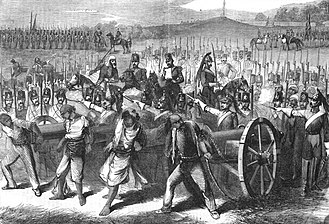India
Sultanate of India | |
|---|---|
 The Sultanate's sovereign territory in 1960 (disputed Maryul shown in light pink). | |
| Status | Imamate |
| Capital | Delhi (judicial) Lahore (executive, legislative) Uch Sharif (executive) |
| Largest city | Delhi |
| Official languages | Rekhta Arabic (liturgical) |
| Other languages | Punjabi Sindhi Cutchi Pashto Persian |
| Religion | Sunni Islam (official) |
The Sultanate of India (Rekhta: دولت هندوستان, dawlat-e-hindustān), commonly known as the Hansviyat (هانسویت), is a state in the western Indian subcontinent established in the aftermath of the Great War, achieving independence from Jambu in 1952. It is a theocratic monarchy ruled by members of the popular Islamic Hansvi movement. The country is bordered by Balochistan and Afghanistan to the west, the disputed territory of Maryul to the north, and Jambu to the east.
Terminology
Internally, the state itself is formally referred to as Dawlat-e-Hindustan ('State of India'). However, the use of the term Hansivyat is more frequent, a term alluding to the Hansvi movement formed with the noun marker -iyat (یت).
In Anglophone contexts, the country is usually referred to as the 'Sultanate of India', either denoting the Indus River running through the length of the Sultanate or to differentiate it from the Indian subcontinent as a whole. It may simply refer to the state as 'India' in appropriate contexts. However, some reject the use of the term 'Sultanate', as the head of state is not referred to as a Sultan within the state.
History
With the decline of the Sikh confederacy, leaders of the Chishti-Nizami Order in the Punjab gained significant spiritual and temporal authority in the late 18th century. During this era, relatively puritan urban Islamic theologians (ulema) began to influence Sufi orders. This alliance between and merger of the temporal power of the orders and the religious authority of the ulema resulted in the adoption of orthodox doctrine, a renewed emphasis on scripture, and increased involvement in regional politics. Under leaders like mujaddid Syed Muhammad Sufyan Hansvi, the Chishti-Nizami Order and its new reformist ideals began to spread through the Punjab, Sindh, and Delhi. In 1793, several pirs allied with the nascent kingdom of Afghanistan. Much like other Sufi silsilas, those in India devoted themselves to an armed and intellectual anti-colonial resistance against the British empire with a renewed emphasis on the sharia and jihad.

The Indian Revolt of 1859 against the British East India Company was a pivotal moment in the history of the subcontinent and marked the genesis of modern, anti-colonial Islamic movements. During the Revolt, several khanaqahs and madrasas became centers of revolutionary activity, while others declared neutrality in order to preserve their property, power, and prestige. The founding of the Darul Ulum of Hansi in 1870 near the shrine of Syed Hansvi marked the beginning of a budding Islamic revivalist movement known as the Hansvi movement. The Darul Ulum of Hansi functioned both as a khanaqah and a madrasa. Over the next three decades, its leading theologians and pirs adopted a number of reforms; the movement became jurisprudentially eclectic, condemned determinism (taqdir) and fatalism (qismat), and incorporated members of the declining Suhrawardy Order. These actions solidified the movement’s regional identity and strengthened connections with new allies. In order to compete with the more puritan Naqshbandi-Mujaddidi Order based in Delhi, they adopted the Rekhta language as their lingua franca, allied with the Ishaqiya of Serindia and the Jahriya of China, established new Islamic seminaries along the Indus, and suppressed internal rivalries and theological disputes. Pir Bahadur Amini, a saint and scholar, was one of the most revered and influential religious figures during this era. He was the first member of the Chishti Order to issue a fatwa and co-founded the Freedom and Fidelity Party (اسلامی تحریک حریت و حقیقت, islami tehrik-e hurriyat wa haqiqat, FFP) in 1924.
In 1933, the leaders of the FFP sent a series of delegates and letters to Austria, France, the Ottoman Empire, Serindia, Afghanistan, and Lahej, with the goal of forming an anti-British alliance. Bejasid IV of the Ottoman Empire, Danial III of Serindia, and Claudia Magdalena of Austria had responded positively to this request, while the other missions are assumed to have failed. On his way back from Constantinople, FFP emissary Farid Akbarabadi was stopped and subsequently arrested by British authorities. Akbarabadi was imprisoned in Georgia the same year along with other conspirators. This incident was known as the Skullcap Plot and contributed to the outbreak of the Great War in 1935.

The next four years saw tensions rise across British India. Sufi revolutionary Pir Syed Serajuddin (the future Pir Nur I) rose to prominence as a senior leader of the FFP and a public spiritual personality. Full-scale rebellion began in British India in 1937, accelerating with the start of the Great War in 1939. In June 1939, the FFP joined the United Jambu Front, forming a coalition against British rule on the subcontinent. Disagreements within the Front about governance and regional representation led to civil unrest and eventually riots starting in 1948. The FFP, allied with regional, monarchist, and Sikh factions, declared their intention to secede from Jambu and establish an independent state. In 1952, the Sultanate was established.
Government and Politics
List of leaders
List of sultans
| Nº | Portrait | Name | Reign |
|---|---|---|---|
| 1 |  |
Pir Nur I Pir Syed Serajuddin (1898–1967) |
26 November 1954 – 20 October 1967 (12 years, 10 months, 24 days) |
| 2 |  |
Pir Nur II Pir Syed Ghulam Mohiuddin (1920-1993) |
11 November 1967 – |